Vin Zollo
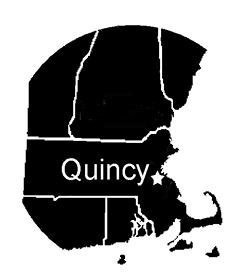 Squantum is the northernmost section of the city of Quincy, Massachusetts. It is a peninsula bordered on the north by Boston Harbor, on the east by Moon Island, on the south by Quincy Bay, and on the west by the Neponset River and the Dorchester section of Boston. Mostly urbanized, Squantum is a mix of traditional neighborhood streets and a more recent and ever-expanding large development in Marina Bay consisting of condominiums, town houses, and the largest marina in the Northeast. Despite the hustle and bustle, this area provides year-round birding opportunities. The natural, more "wild" attractions of Squantum include salt marshes, ocean bays, exposed mudflats, sand spits, an estuarine river, and patches of wooded city parks for landbird migrants. There's much human activity, and birders may field a lot of questions about what they're looking at. This is a great opportunity to share information about bird sightings, spread knowledge about local nature, and in turn, learn more about the area from people who live here.
Squantum is the northernmost section of the city of Quincy, Massachusetts. It is a peninsula bordered on the north by Boston Harbor, on the east by Moon Island, on the south by Quincy Bay, and on the west by the Neponset River and the Dorchester section of Boston. Mostly urbanized, Squantum is a mix of traditional neighborhood streets and a more recent and ever-expanding large development in Marina Bay consisting of condominiums, town houses, and the largest marina in the Northeast. Despite the hustle and bustle, this area provides year-round birding opportunities. The natural, more "wild" attractions of Squantum include salt marshes, ocean bays, exposed mudflats, sand spits, an estuarine river, and patches of wooded city parks for landbird migrants. There's much human activity, and birders may field a lot of questions about what they're looking at. This is a great opportunity to share information about bird sightings, spread knowledge about local nature, and in turn, learn more about the area from people who live here.
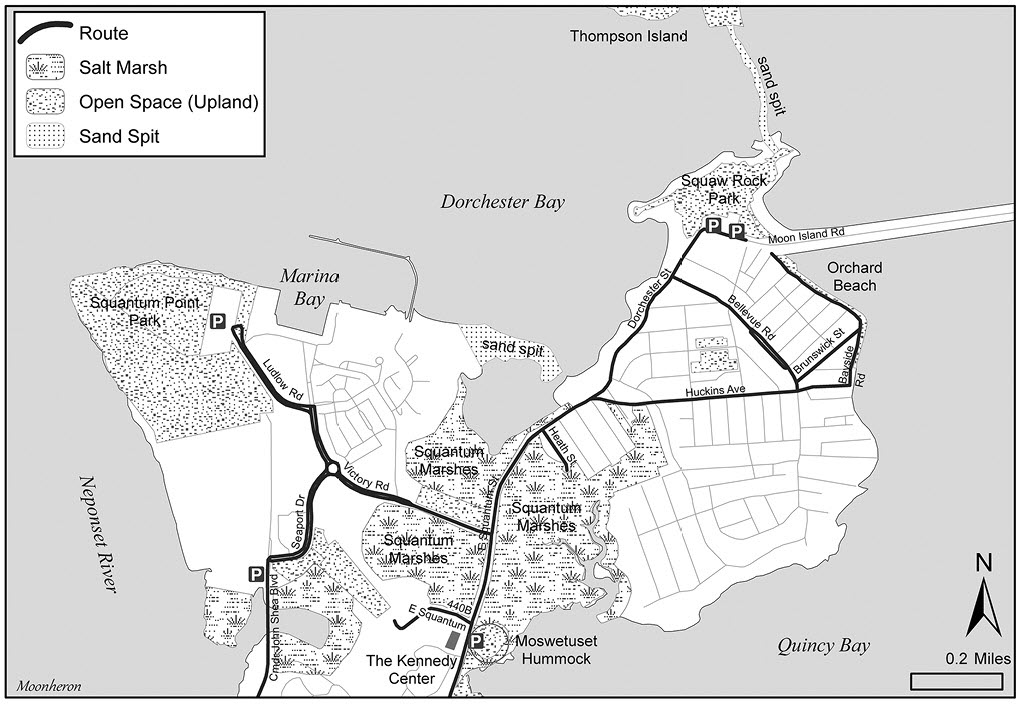
Fig. 1. Overview map of Squantum.
History
Only minutes south of Boston, the city of Quincy has a rich history. Referred to by some as the city of presidents, it is the birthplace of the second and sixth presidents of the United States, John Adams and John Quincy Adams, and is home to Adams National Historic Park. Quincy is the birthplace of John Hancock, the first signer of the Declaration of Independence and first American governor of Massachusetts, and it is the site of the Granite Railway, America's first commercial railway.
Squantum derives its name from the Native American guide and interpreter, Tisquantum or Squanto, who brought the Plymouth Colony commander Myles Standish to visit Chief Chickatawbut of the Massachusett tribe at his ruling seat on Moswetuset Hummock in Squantum in 1621. Moswetuset is believed to be the origin for the name of the Massachusett tribe.
Additionally, Squantum played a role in aviation dating back to the first part of the twentieth century. Squantum Point was a site for early airshows. The original civilian airfield— where Amelia Earhart was employed as chief pilot—dates back to 1910; it later became Naval Air Station Squantum, an active military base from 1923–1953.
Logistics
Squantum is a well-defined, relatively compact area—2.7 square miles—that starts at the intersection of East Squantum Street and Quincy Shore Drive. You can cover all of the featured birding locations within Squantum in as little as 2–3 hours or more extensively in 5–6 hours, depending on your pace. A good understanding of the tides will help you locate more birds, and if you have a vehicle you can optimize your birding success by moving from location to location to adapt to changing tides. Specific tide details will be discussed in site descriptions. A spotting scope can enhance your views of waterfowl and shorebirds. If you prefer a guided tour, the South Shore Bird Club (https://southshorebirdclub.wixsite.com/ssbc) offers a few trips every year.
Driving directions: From Interstate 93, take Exit 12: MA - 3A S/Gallivan Blvd. Continue straight onto Hancock Street/Neponset Avenue for approximately one mile, keeping left on Quincy Shore Drive. Turn left onto East Squantum Street just before Wollaston Beach.
Arrive by public transportation with the Massachusetts Bay Transportation Authority (MBTA), stopping at the nearby North Quincy Station. MBTA bus #211 makes stops in Squantum.
There are no public bathroom facilities in Squantum, so plan ahead. Dunkin' at the corner of East Squantum Street and Quincy Shore Drive has a bathroom. Or try your luck at one of the restaurants at Marina Bay's Victory Road waterfront.
Moswetuset Hummock
As its name suggests, the Hummock is a small, elevated, mostly oak-treed city park that looks out over Quincy Bay and an adjacent salt marsh. It is located along the main causeway at the beginning of Squantum and is next to the north end of Wollaston Beach. The parking lot is directly across the street from the Kennedy Center building at 440 East Squantum Street. (See Figure 1. Overview Map of Squantum.)
The main trail follows the outside edges of the hummock and affords fine views. Morning light can be in your face when looking out into Quincy Bay, so if possible, visit midday or in the afternoon. Scan the salt marsh for Great and Snowy egrets and Glossy Ibis (uncommon) at higher tides. There is an active Osprey platform in the marsh. Other birds include resident American Black Ducks and summering Willets, Least Terns, and Barn and Tree swallows. In winter, check elevated perches at dusk for a Snowy Owl during flight years.
Look south to Quincy Bay. High tide is best for views of wintering seafowl from mid-October through mid-April. Expect American Black Ducks, Common Eiders, Surf and White-winged scoters, Buffleheads, Common Goldeneyes, Red-breasted Mergansers, Common and Red-throated loons, and Horned Grebes. Less common are Greater Scaup and Long-tailed Ducks. The occasional dabbling duck can be spotted among the Black Ducks, especially after a quick, early winter freeze of inland bodies of water.
Low tide reveals extensive mudflats that can attract a variety of shorebirds and wading birds, with peak numbers from July to mid-September. A rising tide is best because it will push birds closer toward you. There should be Semipalmated Plovers, Semipalmated Sandpipers, and Greater Yellowlegs; fewer Black-bellied Plovers, Least Sandpipers, Spotted Sandpipers, White-rumped Sandpipers (uncommon), Short-billed Dowitchers, and Lesser Yellowlegs. Look carefully through these flocks because Western Sandpiper is found annually in small numbers. Post-breeding Laughing Gulls forage along the water's edge from July through October in addition to the resident Ring-billed, Herring, and Great Black-backed gulls. Great Blue Herons, Great Egrets, and Snowy Egrets also work the shallows, adding height and color to the feeding scene.
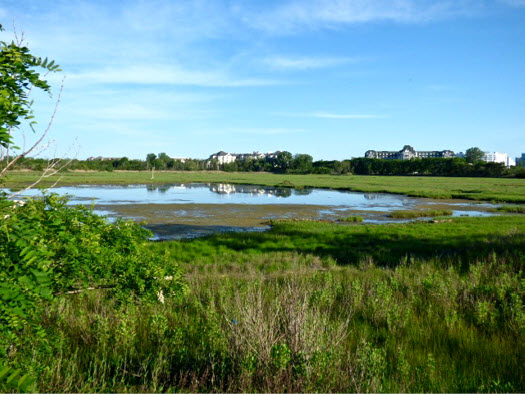
Squantum pans next to Kennedy Center. All photographs by the author unless otherwise
indicated.
The waters around Squantum seem to be a major staging area for migrating Double-crested Cormorants, where it's not uncommon to see a few thousand in the fall. Flocks of one hundred or more regularly depart for points south or southwest, especially early in the morning. Moswetuset Hummock is one of several vantage points around Squantum where one can witness large feeding frenzies during October, as masses of Double-crested Cormorants herd baitfish in the surrounding bays, which also attracts gulls, terns, and fish-eating waterfowl, particularly Red-throated Loons. Among the masses of gulls and terns, look for Bonaparte's Gulls keying in to these feeding aggregations. The majority of the terns are Common Terns, but a Forster's Tern or two are possible with a thorough search.
The wooded part of Moswetuset Hummock can host passerines during migration. This is a classic "boom or bust" type of spot, but frequent visits can yield results. April migrants such as Ruby-crowned and Golden-crowned kinglets, Hermit Thrushes, Brown Creepers, Eastern Phoebes, and Northern Flickers can be viewed well before the foliage pops.
Squantum Marshes
The Squantum Marshes are patches of salt marsh along East Squantum Street. (See Figure 1). The first and most frequently birded of these is on the north side of East Squantum Street adjacent to the Kennedy Center. This marsh features salt pans or pools that host a wide variety of shorebirds, wading birds, and waterfowl in season. It is most productive from spring through fall. The ideal conditions here are during a high tide, preferably in the morning when the light is at your back. This is the location in Squantum during high tide because shorebirds get pushed out of their feeding areas on the incoming tide and congregate in these salt pans.
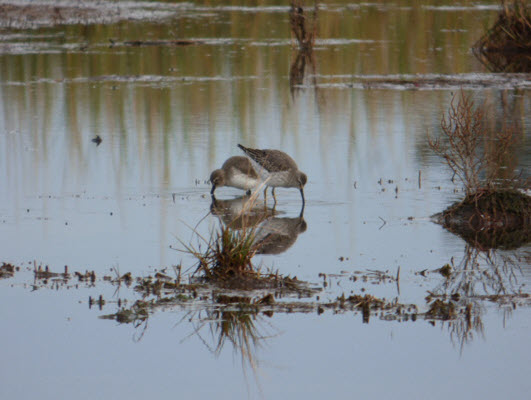
Stilt Sandpiper and Dunlin at Squantum pans next to Kennedy Center.
Park either at the Moswetuset Hummock lot across the street or alongside the marsh on the side road, 440B East Squantum Street, which is the north entrance to the Kennedy Center. This side road is a good place to begin birding. The largest pool touches the edge of the road, and a vehicle can make a nice blind as you initially scan. To get a more commanding view of all the pools and the marsh as a whole, walk along the sidewalk on the main road, East Squantum Street. Killdeer and Willets breed here. Other regular shorebirds include Semipalmated Plover, Least and Semipalmated sandpipers, Short-billed Dowitcher, and Greater and Lesser yellowlegs. Less frequent, but regular are Pectoral, White-rumped, and Stilt sandpipers, as well as Dunlin (October). This marsh is one of only a few places in the Boston area that regularly host Stilt Sandpipers. The pools here are their favored habitat. Be on the lookout for Whimbrels, Western Sandpipers, and Long-billed Dowitchers, all rare but annual. Wilson's Phalarope is possible, with a few sightings in the past decade.
All of this shorebird activity attracts the attention of avian predators. The sudden flushing of the flocks is a sure sign that a predator is about. Peregrine Falcons, Merlins, and Cooper's Hawks are the main pursuers and can totally clear the area of all shorebirds, a spectacular sight, but it can also cut your birding visit short.
A dawn visit between July and mid-September can be quite rewarding. Up to 75 Great and Snowy egrets and a few Great Blue Herons congregate in the pans at daybreak, which makes for a spectacular up-close but short-lived encounter. Most of these birds disperse to more productive feeding spots within about 15 minutes. Keep an eye on the sky as well because Black-crowned Night Herons fly over with some regularity as they head to their daytime roost.
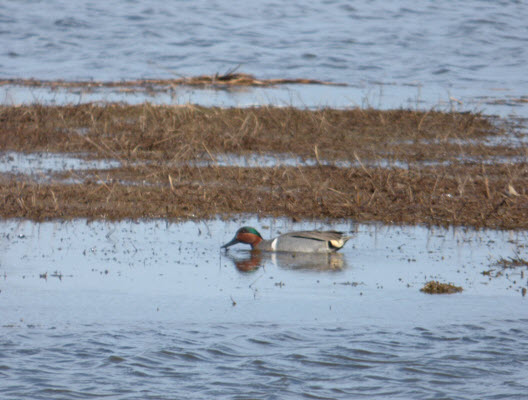
Green-winged Teal at Squantum pans next to Kennedy Center.
This section of salt marsh hosts two breeding birds of conservation concern. American Black Ducks are often overlooked as breeders in the area. Lucky observers can encounter black duck hens with ducklings in tow mostly during the month of May. This species has declined sharply as a breeding bird in Massachusetts over the past 25 years, especially away from coastal areas.
Saltmarsh Sparrows also nest here, perhaps six pairs. Scan carefully—a scope is useful—for teed-up Saltmarsh Sparrows in the marsh. Patience is required because these secretive birds move around a lot and many times dive into the vegetation and disappear. This salt marsh specialist nests only on the Atlantic Coast from Maine to Virginia and is at center stage in the discussion about the impact of climate change on birds. Leading authorities predict successful nestings of these salt marsh denizens will diminish as sea levels continue to rise (Gorman 2018). I have not personally noticed a change in numbers at this particular spot, but one can't help to think about their fate as time goes by.
Barn Swallows nest in an abandoned storage building next to the marsh and are a welcome distraction as they hunt low over this open area. Squantum is not known for numbers or variety of dabbling ducks. Along with Mallard and American Black Duck, Green-winged Teal is the only regular dabbler during migration in these pools. On occasion, Blue-winged Teal and Northern Shovelers drop in for a brief stay. A few Least Terns hover over the pools in the summer. This state-listed species of special concern likely nests nearby on one of the Boston Harbor islands. Glossy Ibises occasionally feed in the marshes in spring and summer. A number of exciting rarities have been spotted over the years, including Baird's Sandpiper, Curlew Sandpiper, Red-necked Phalarope, Clapper Rail, Tricolored Heron, and White-faced Ibis. Odonate aficionados will notice the seaside dragonlet (Erythrodiplax berenice) skimming low over the salt pans. This small dragonfly is the only North American species that can breed in seawater.
Directly behind the Kennedy Center are a small patch of phragmites marsh, an old weedy baseball field, and some early successional brushy habitat that hold some interesting birds in spring and fall migrations. Look for Wilson's Snipe in early April. A small section of the old ballfield is tidal and can be wet, but a walk through it can be productive, with Song, White-throated, Swamp, and Savannah sparrows and the possibility of Field, White-crowned, or Lincoln's sparrows. Autumn migration days may feature many Yellow-rumped Warblers and others such as Palm Warbler, Common Yellowthroat, and Blackpoll Warbler. This is the right habitat to hope for an uncommon Orange-crowned Warbler. Listen for Willow Flycatcher; a pair regularly breeds in the brushy area behind the old ballfield.
Return to East Squantum Street and either walk or drive for 0.4 mile, then turn right onto Heath Street, and continue to the end of the cul-de-sac to view another section of salt marsh with an osprey platform. If the tide is high, it's worth checking the marsh, boat docks, and walkways that jut out into the marsh for birds; bypass this area at low tide. Before returning to East Squantum Street, park on Heath Street and cross the main road to scan north at the seawall into the waters of Dorchester Bay. The large condominium buildings of Marina Bay are in view across the bay with the Boston skyline in the background.
This small embayment has nice birds and views, but is best with morning light and on a lower tide when the mudflats and sand spit are exposed. A spotting scope is useful for scrutinizing shorebirds and waterfowl. American Oystercatchers—local breeders—and Black-bellied Plovers frequent the sand spit, as do Laughing Gulls between July and October. The spit is one of a few places in the area to try for Caspian Terns in September. Semipalmated Plovers, Least and Semipalmated sandpipers, and Greater Yellowlegs regularly feed on the mudflats. Less common shorebirds such as Ruddy Turnstones, Sanderlings, Dunlins (October), White-rumped Sandpipers, Pectoral Sandpipers, Western Sandpipers (rare), Short-billed Dowitchers, and Willets round out the possibilities. Common and Least terns feed along this stretch of water during the summer months. Keep an eye out for Black Skimmers, which are rare but can occur in some years. It is thought that juvenile birds disperse from breeding grounds to the south and feed in these shallow bays in late summer. Black-headed Gull and Red Knot are a couple of rarities that have shown up in recent years.
This is another favored spot for wading birds such as Great and Snowy egrets and Great Blue Herons. Flocks of Brant, sometimes numbering in the hundreds, use this area; peak numbers occur during spring and fall migrations. The seawall is another vantage point from which to view the feeding frenzies of cormorants, gulls, terns, and fish-eating waterfowl.
Squaw Rock Park
Squaw Rock Park is Squantum's best migrant trap, another classic "boom or bust" kind of place during migration. Birders know it as Squaw Rock, but it also goes by Nickerson Beach or Chapel Rocks. Continue driving along East Squantum Street and go left when the road forks; it becomes Dorchester Street, hugging the seawall. In about 0.6 mile, just before the road curves right, you'll approach a wooded area on the left and then a set of low cinder block buildings (a former Cold War Nike missile site). You can park along the road in front of the Mollie Hirshberg Learning Center or turn left into the parking lot for the Robert I. Nickerson VFW Post 382. A trail skirts the edge of the park, and several less-traveled trails crisscross the center. It's easy to find your way around this small property. (See Figure 2. Map of Squaw Rock Park.)
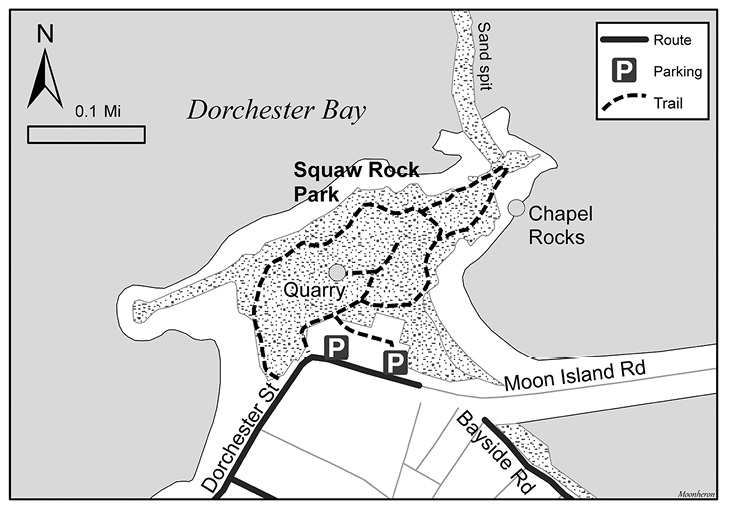
Fig. 2. Map of Squaw Rock Park.
More than thirty species of warblers have been seen at Squaw Rock Park. May has the highest diversity, with Common Yellowthroats, American Redstarts, Northern Parulas, and Black-and-white, Magnolia, Yellow, Blackpoll, Black-throated Blue, Yellow-rumped, Black-throated Green, and Wilson's warblers among the most frequently encountered. Flycatchers such as Eastern Wood-Pewee, Least Flycatcher, Eastern Phoebe, Great Crested Flycatcher, and Eastern Kingbird are expected. Yellow-bellied and Alder flycatchers are rare but possible in late May through early June. Yellow-billed and Black-billed cuckoos, as well as Red-eyed, Blue-headed, Warbling, and Philadelphia (uncommon; September) vireos pass through, as do Golden-crowned and Ruby-crowned kinglets, and Hermit and Swainson's thrushes. During fall migration, be on the lookout for Field, Fox, White-crowned, White-throated, Lincoln's, and Swamp sparrows.
The habitat of this city park is mostly wooded with a few patches of open early successional growth, and a tiny, inactive quarry. Because this patch of green is surrounded by development and is situated at the coast, almost anything is possible. Kentucky Warbler, Summer Tanager, and Ash-throated Flycatcher are just a few of the many rare birds recorded here.
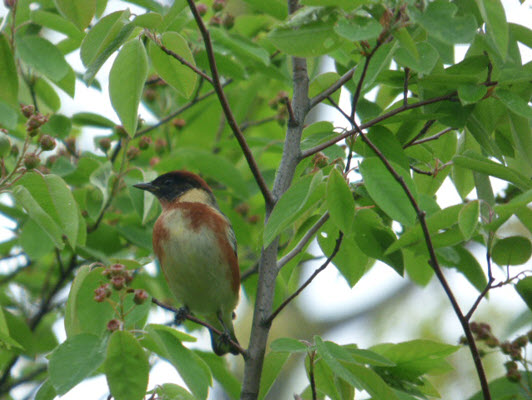
Bay-breasted Warbler at Squaw Rock.
A tiny, long-defunct quarry sits roughly in the middle of the park. The vegetation is lower here and makes a nice semi-open area from which to watch for migrants. Black-crowned Night Herons sometimes roost in the trees on the edge of the quarry. Northern Rough-winged Swallows have nested here. This is also a good spot to find Eastern Screech Owls.
A midsummer visit isn't as rewarding as during migrations, but expect Gray Catbirds, Northern Cardinals, Yellow Warblers, American Goldfinches, Cedar Waxwings, Chimney Swifts, Northern Mockingbirds, Carolina and House wrens, American Crows, Downy Woodpeckers, Blue Jays, and Cooper's Hawks. Sometimes you can find Spotted Sandpipers along the shoreline.
The elevations at Squaw Rock provide several vantage points for looking at Boston Harbor, with fantastic views of the Boston skyline and some of the Harbor Islands, as well as commanding views of October feeding frenzies and of wintering waterfowl. Directly north is Thompson Island, part of the Boston Harbor National Recreation Area. Between these two land masses there is a prominent sand spit that attracts gulls, terns, cormorants, and shorebirds on a rising tide. This is a consistent spot for American Oystercatchers and Black-bellied Plovers in season. It is also one of the best places in the state to see Caspian Terns in September.
Orchard Beach
Orchard Beach is a tiny public beach in a quieter section of Squantum that looks out onto Quincy Bay. Tide isn't as critical here, but morning light is unfavorable. From Squaw Rock Park, head back on Dorchester Street for 0.2 mile, take a left onto Bellevue Road, continue for 0.4 mile, and turn left onto Huckins Avenue. In 0.1 mile, turn left onto Bayside Road, then park along the seawall. Orchard Beach is another good location to witness feeding frenzies.
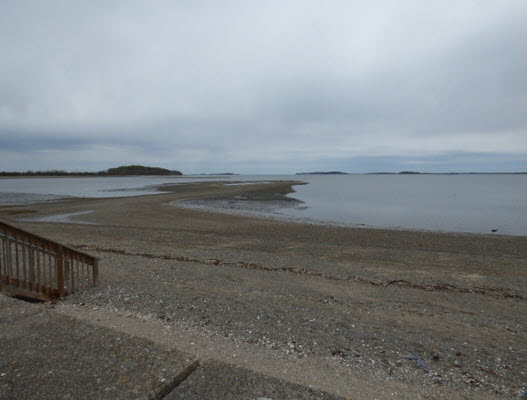
Orchard Beach
At high tide, check the large rock formation on the right that juts out into the water from the end of the beach. This is a favorite daytime roosting or resting spot for American Oystercatchers and Laughing Gulls. Look for the occasional Forster's Tern mixed in with the Common Terns.
Lower tides bring in shorebirds and roosting gulls and terns. Black-bellied and Semipalmated plovers, as well as a few Ruddy Turnstones favor this area. A scan of the waters can yield impressive numbers of Red-throated Loons during migration as well as a few Long-tailed Ducks in winter and early spring. Search for Northern Gannets; curiously, some gannets regularly come into the protected bays during a tight window of time in early April. Brown Pelican, Royal Tern, and Parasitic Jaeger are a few of the rarities seen at Orchard Beach.
To return to East Squantum Street, take the first left (0.1 mile) from Bayside Road onto Brunswick Street. Drive 0.2 mile to the end, and take a left on Bellevue Road, then an immediate right onto Huckins Avenue. Take Huckins Avenue for 0.4 mile, and turn left at the end to get back on the main causeway.
Marina Bay and Squantum Point Park
Most of the birding opportunities in Marina Bay, or New Squantum, center around Squantum Point Park. If you are going to begin your birding trip here, take Victory Road, which is the first left off of East Squantum Street after passing the Kennedy Center. Coming from Squaw Rock, take a right onto Victory Road. Proceed for 0.4 mile to a rotary, continue on Victory Road for another 0.2 mile, then take the first left onto Ludlow Road, which has no street sign. Continue on Ludlow Road for 0.2 mile, then turn left at the entrance to Squantum Point Park into a large parking lot. The first hour of parking is free, but there is a fee if you stay longer.
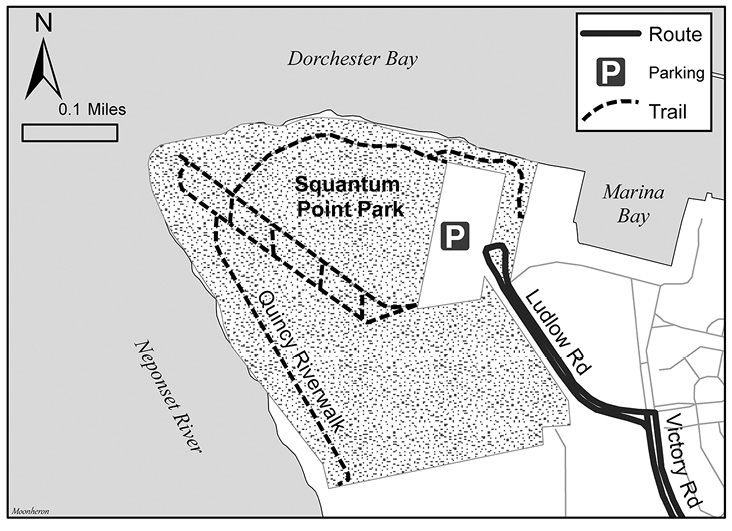
Fig. 3. Map of Squantum Point Park.
This state park, run by the Massachusetts Department of Conservation and Recreation, is approximately 50 acres, consisting of mostly wet, early successional forest and the maintained grassy strip of the former airport runway. The Neponset River flanks the west side of the property and flows into Dorchester Bay. (See Figure 3. Map of Squantum Point Park.) Two entry points at either end of the parking lot lead to the loop walkway around the old airstrip. An early morning visit is preferable because this is a favorite place for dog walkers.
At the north tip of the paved loop is Squantum Point, which provides an open view of estuarine waters. This is a consistent location during the cold months for Red-throated Loons as well as a place to look for a rare Barrow's Goldeneye or King Eider. Check the sandbars on the lower tides for American Oystercatchers and Caspian Terns in season.
In spring, a few American Woodcocks display at dusk in the open areas. Listen also for Virginia Rail, which has been known to nest in the remnant cattail marsh on the west edge of the runway loop. Expect breeding Yellow Warblers, Common Yellowthroats, Cedar Waxwings, and a pair or two of Willow Flycatchers.
The remaining patches of thicket habitat attract a variety of fall and early winter migrants. Chief among them are Yellow-rumped, Palm, and Blackpoll warblers, several species of sparrows, Hermit Thrush, and Golden-crowned and Ruby-crowned kinglets. Look for Lincoln's, White-crowned, American Tree, and Fox sparrows on the weedy edges of the old runway. Check for late-season migrants such as Orange-crowned Warblers and Yellow-breasted Chats, which are rare, but there is favorable habitat here. A Boreal Chickadee in 2010 delighted birders and also led to the discovery of a rare Le Conte's Sparrow. One can encounter American Robins during fall and winter as they go to and from their roosts at dawn or dusk. This concentration of birds attracts the attention of birds of prey, most notably Cooper's Hawks and the occasional Merlin.
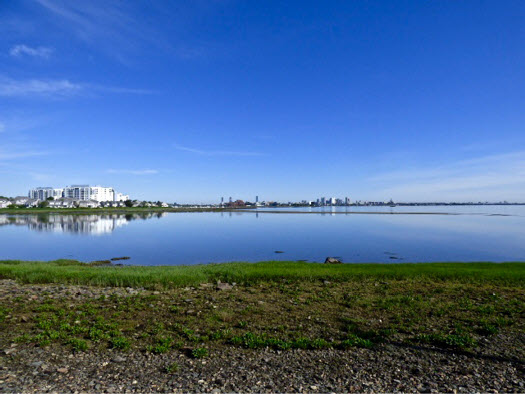
Marina Bay spit looking from across Heath Street
The recently-completed Quincy Riverwalk offers access to the west side of Squantum Point Park as well as the northwest corner of loop around the old airstrip. Don't forget to cover the south end of the loop. Look at the abandoned runway through the vegetation along the chain link fence. Shorebirds, wading birds, and dabbling ducks may be in there when it is flooded. Blue-winged Teal and Northern Shovelers sometimes drop in, and it is an alternative spot to check for Glossy Ibis.
Commander Shea Boulevard
Retrace your route from Squantum Point Park and head down Ludlow Road, then turn right onto Victory Road. At the rotary, take the first right onto Seaport Drive. Follow it 0.3 mile to the end, and take a left onto Commander Shea Boulevard. Almost immediately there is a small parking area on the right with a kiosk for the Quincy Riverwalk. The Commander Shea Boulevard area features small sections of salt marsh and nice views of the Neponset River. If you would prefer a longer walk, you can combine birding this area with Squantum Point Park because the riverwalk connects the two properties. Refer to the kiosk map for more details.
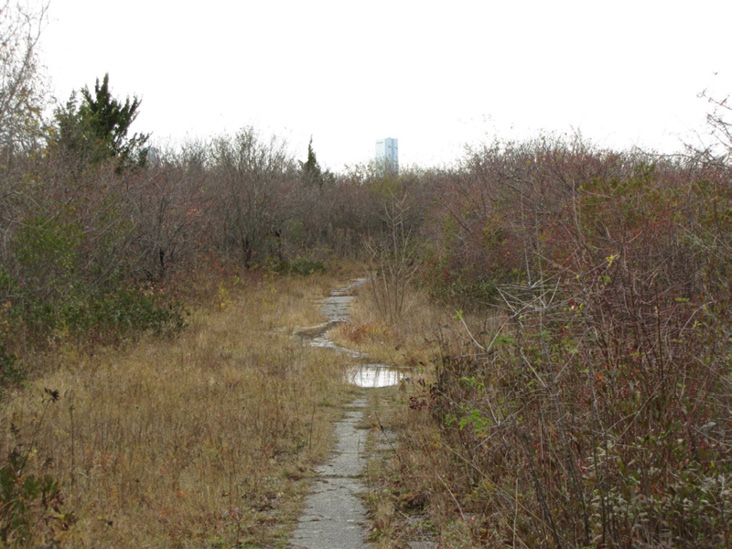
Squantum Point Park thicket. Photograph by Peter Oehlkers.
Follow the trail along the marsh toward the Neponset River. Scan for waterfowl and shorebirds and the occasional Caspian Tern flying over the water. This area is also an alternative feeding and roosting site for Greater Yellowlegs. Watch for Black-crowned Night Herons flying by at dawn or dusk. Uncommon and secretive, Nelson's Sparrows may be in the adjacent salt marsh from late September to mid-October. Check the creek opposite the parking area for American Black Ducks and Belted Kingfishers.
For passerine migrants, walk south along Commander Shea Boulevard for about 0.2 mile. At the wooded area, there is a path on the east side of the road that winds through young forest and the edge of the salt marsh.
Reference
Vin Zollo lives in Walpole, Massachusetts, with his wife and two kids and works on the property staff at Mass Audubon's Moose Hill Wildlife Sanctuary in Sharon, Massachusetts. His longtime passion for the environment was ignited 25 years ago during a Winter Raptors trip led by Blue Hills Trailside Museum director Norman Smith. Bird-related activities include leading bird trips for Mass Audubon and the South Shore Bird Club, field trip coordinator for the South Shore Bird Club, overseeing Moose Hill's Bird-a-thon team, and raptor banding (currently studying migration of Northern Saw-whet Owls). His other interests include sports, exploring new places, and learning about Odonates.